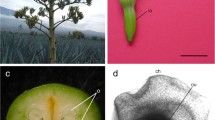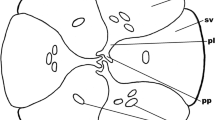Summary
Embryo-sac formation in six cultivated Asian cassava clones and one unknown ‘wild type’, was histologically investigated to determine apomictic potential in the genus Manihot. All the 6 clones were found to possess one single sexual embryo-sac containing 6–8 nuclei at maturity. However, one clone, ‘Rayong 3’ possessed two functional embryo-sacs at 12 hours after controlled pollination (HACP). The larger embryo-sac was 6-nucleate (all 3 nuclei of the egg apparatus, 1 polar and 2 antipodal cells) and located towards the ‘false micropylar’ or the nucellar beak region. The smaller embryo-sac also contained a total of 6 nuclei and approximately 10 μm3 or 1/2 the volume of the former and located towards the chalazal pole. Percentage sexuality estimates indicated a 100% sexual reproduction in embryo-sacs of all the clones analysed. However, apomeiotic relationships indicate a low (0.3%) degree of meiotic diplosporous embryo-sac formation, thus suggesting facultative apomixis in cv. ‘Rayong 3’. This is the first embryological identification and evidence of apomeiosis and apomictic potential in cassava.
Similar content being viewed by others
References
Bashaw, E.C., 1980. Apomixis and its application in crop improvement. In: W.R. Fehr & H.H. Hadley (Eds) Hybridization of Crop plants. pp. 45–62. American Society of Agronomy/Crop Science Society of America, Madison, W.I.
Carderini, O. & A. Mariani, 1995. Megagametophyte organization in diploid alfalfa meiotic mutants producing 4n pollen and 2n eggs. Theor. Appl. Genet. 90: 135–141.
Capinpin, J.M. & V.C. Bruce, 1955. Floral biology and cytology of Manihot utilissima. Philippine Agriculturist 39 (16): 306–316.
Chandraratna, M.F. & K.D.S.S. Nanayakkara, 1948. Studies in Cassava. II. The production of hybrids. Trop. Agric. 104: 59–74.
Dujardin, M. & W.W. Hanna, 1985. Cytology and reproduction of reciprocal backcrosses between pearl millet and sexual and apomictic hybrids of pearl millet x Pennisetum squammulatum. Crop Sci. 25: 59–62.
Graner, E.A., 1935. Contribution to the cytological study of cassava. Piracicaba, Brazil, Escola Superior de Agricultura ‘Luiz de Queiroz’. (In Portuguese with English abstract) 28 p.
Hahn, S.K., K.V. Bai & R. Asiedu, 1990. Tetraploids, triploids, and 2n pollen from diploid interspecific crosses with cassava. Theor. Appl. Genet. 79: 433–439.
Hershey, C.H., 1993. Cassava (Manihot esculenta Crantz). In: G. Kalloo & B.O. Bergh (Eds) Genetic improvement of vegetable crops. pp. 669–691. Pergamon Press, Oxford.
IITA, 1988. IITA annual report and research highlights, 1987/88, pp. 122–125.
IITA, 1990. Cassava in Tropical Africa. A reference manual. International Institute of Tropical Agriculture, Ibadan, Nigeria.
Jefferson, R.A., 1993. Beyond Model Systems: New strategies, methods and mechanisms for agricultural research. Biotech. R & D Trends 700: 53–73.
Kawano, K., 1980. Cassava: In: W.R. Fehr & H.H. Hadley (Eds) Hybridization of Crop plants, pp. 225–233. American Society of Agronomy/Crop Science Society of America, Madison, W.I.
Kawano, K., A. Limsila, A. Tongglum & D. Superhan, 1990. Cassava cultivar evolution viewed through harvest index and biomass production. Proc. 8th Intl. Trop. Root Crops., ISTRC, Bangkok, pp. 202–210.
Koltunow, A.M., 1993. Apomixis: Embryo-sac and embryos formed without meiosis or fertilization in ovules. Plant Cell 5: 1425–1437.
Mendiburu, A.O. & S.J. Peloquin, 1976. Sexual polyploidization and depolyploidization: some terminology and definitions. Theor. Appl. Genet. 48: 137–143.
Mol, R., E. Mathyl-Rochon & C. Dumas, 1994. The Kinetics of cytological events during double fertilization in Zea mays L. The Plant Journal 5 (2): 197–206.
Nakagawa, H., 1990. Embryo-sac analysis and crossing procedure for breeding apomictic guinea grass (Panicum maximum Jacq.) JARQ 24: 163–168.
Nakagawa, H., N. Shimizu & W.W. Hanna, 1993. Cytology of ‘Natsukaze’ Guinea grass, a natural apomictic hybrid between a sexual and an apomictic plant. J. Japan. Grassl. Sci. 39: 374–380.
Nakajima, K. & N. Mochizuki, 1983. Degree of sexual plants of guinea grass by the simplified embryo sac analysis. Japan. J. Breed. 33: 45–54.
Ogburia, N.M. & T. Adachi, 1994a. Embryological basis of fertilization failure in Cassava (Manihot esculenta Crantz). Breed. Sci. 44 (suppl. 2): 270.
Ogburia, N.M. & T. Adachi, 1994b. An improved cleared-pistil technique for rapid in toto observation of embryo-sac malformation in Cassava (Manihot esculenta Crantz). Abstracts booklet. pp. 37. Proceedings of the Second International Scientific Meeting, CBN II, held at Bogor, Indonesia, 22–26 August 1994. CBN/CIAT, Colombia CRIFC/AARD, Indonesia.
Ogburia, N.M. & T. Adachi, 1995. Embryo-sac morpho-structural analysis of developmental pathways of fertilization failure, seed abortion and poor germination in Cassava (Manihot esculenta Crantz). Cytologia 60: 75–84.
Rao, N.P. & D. Rao, 1976. Embryology of cassava. Proc. Indian Natn. Sci. Acad. Vol. 42, Part B, Nos, 2 & 3, 111–116.
Sarakarn, S., 1993. Cassava varietal improvement in Thailand. TCDC/FAO/Japanese Govt. project paper. pp. 1–15.
Skiebe, K., 1958. Bedeutung von unreduzierten Gameten fur die Polyploidiezuchtung bei der Fliederprimel (Primula malacoides Franchet) Zuchter 28: 353–359.
Tang, C.Y., K.F. Schertz & E.C. Bashaw, 1980. Apomixis in Sorghum lines and their F1 progenies. Bot. Gaz. 141 (3): 294–299.
Tavoletti, S., 1994. Cytological mechanisms of 2n egg formation in a diploid genotype of Medicago sativa subsp. falcata, Euphytica 75: 1–8.
Veilleux, R., 1985. Diploid and polyploid gametes in crop plants: Mechanisms of formation and utilization in plant breeding. Pl. Breed. Rev. 3: 253–288.
Author information
Authors and Affiliations
Additional information
Contribution from Plant Breeding Laboratory, Applied Genetics & Biotechnology Division, Faculty of Agriculture, Miyazaki University, No. 91.
Rights and permissions
About this article
Cite this article
Ogburia, M.N., Adachi, T. Histological analysis of embryo-sac formation and detection of meiotic diplospory in cassava (Manihot esculenta Crantz). Euphytica 88, 9–16 (1996). https://doi.org/10.1007/BF00029260
Received:
Accepted:
Issue Date:
DOI: https://doi.org/10.1007/BF00029260




